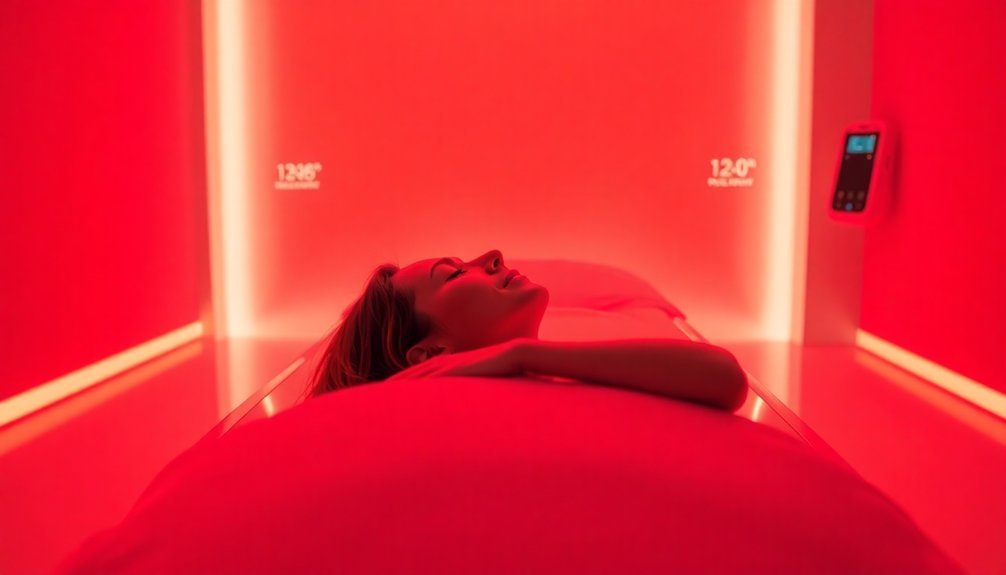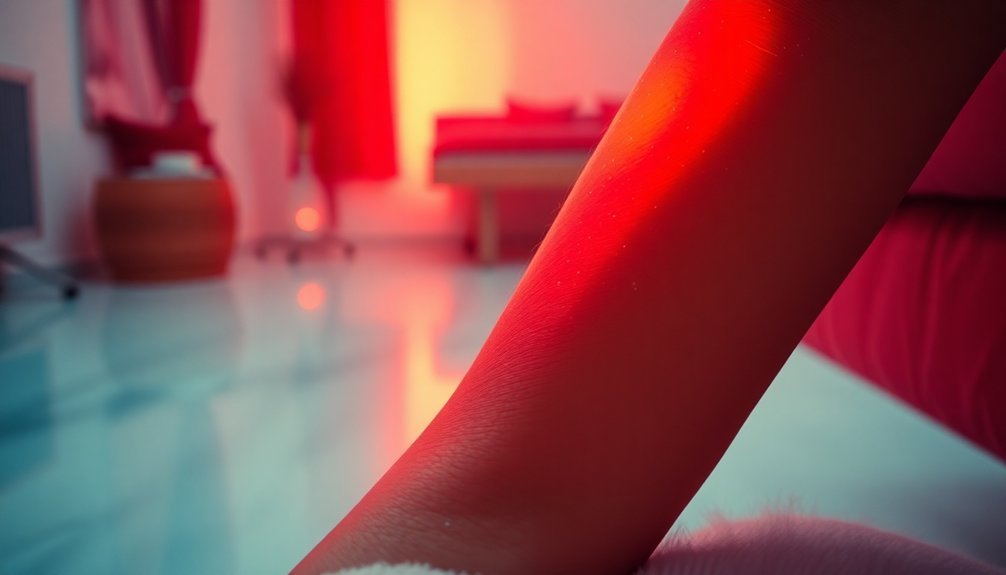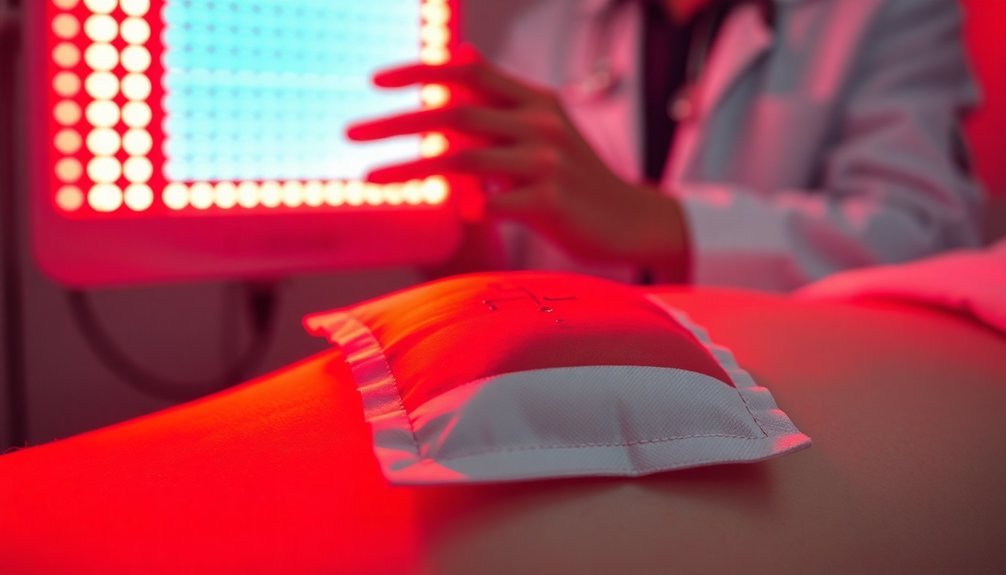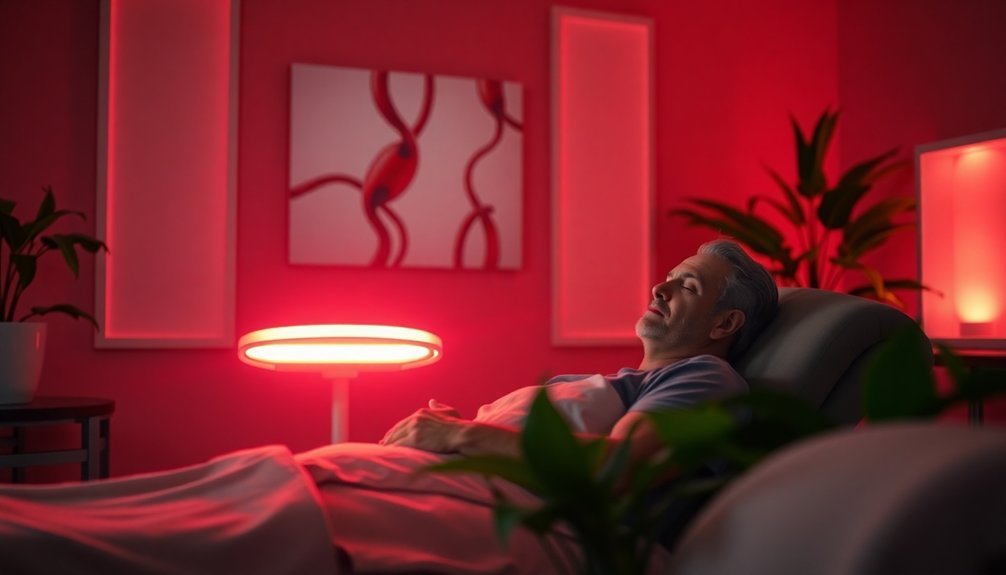Red light therapy can greatly speed up your recovery from diabetes by improving blood sugar control and enhancing cellular energy. By reducing glucose spikes and increasing insulin sensitivity, it helps manage your blood sugar levels more effectively. This therapy also fights chronic inflammation, which is vital for overall metabolic health. Additionally, the increased blood flow promotes faster wound healing—a key issue for those with diabetes. With neuroprotective properties and potential for broader health benefits, this innovative approach could greatly benefit you. Discover how it all connects and what it could mean for your health journey.
Improved Blood Sugar Control

Red light therapy often shows significant promise in improving blood sugar control, particularly for those managing diabetes or prediabetes. Research indicates that this therapy can result in a notable 27.7% reduction in blood glucose levels after glucose intake, over just two hours.
When applied for 15 minutes at a wavelength of 670 nm before a glucose test, you could experience less extreme blood sugar spikes post-meal.
Moreover, using red light therapy appears to reduce maximum glucose levels by 7.5% compared to those who don't receive the treatment. This mitigation of sugar spikes is essential for maintaining stable blood sugar, helping you avoid damaging fluctuations that can affect your health. Additionally, increased cellular energy from red light therapy promotes better metabolic processes that support overall blood sugar management.
Enhanced Cellular Energy
Boosting cellular energy is vital for overall health, especially for those managing diabetes. Red light therapy can greatly enhance your cellular energy levels, which in turn supports better recovery. Here's how it works:
1. Increased ATP Production: Red light stimulates your mitochondria, enhancing the production of ATP, the energy currency of your cells. This allows your cells to perform functions more efficiently.
2. Improved Mitochondrial Function: The therapy boosts the activity of cytochrome c oxidase, akin to adding more 'solar panels' to your mitochondria. This process helps optimize cellular energy production.
Healthy mitochondria are essential for ideal cellular function and metabolic health.
3. Enhanced Cellular Activity: Increased energy leads to greater cell activity, improving tissue repair and overall metabolic functions, including glucose metabolism.
This helps your body in effectively managing diabetes.
Anti-Inflammatory Effects

How can controlling inflammation improve your diabetic management? By incorporating red light therapy (RLT), you can notably reduce chronic inflammation, a known contributor to insulin resistance. RLT lowers the production of pro-inflammatory cytokines while boosting anti-inflammatory cytokines, positively impacting your metabolic health.
When inflammation decreases, your cells become more sensitive to insulin, enabling them to use glucose efficiently and, in turn, lower your blood sugar levels.
Moreover, RLT enhances the healing process for any diabetic wounds you might experience. Its anti-inflammatory properties promote collagen synthesis and cellular proliferation, which are essential for wound recovery. Additionally, RLT accelerates wound healing through increased ATP production, providing energy for recovery processes.
By addressing chronic inflammation, RLT tackles the challenges you're likely to face with diabetic foot ulcers and other healing issues.
Additionally, RLT can prevent diabetes-related complications by managing inflammation and improving your body's metabolic functions. You'll likely find that the therapy can help reduce glucose spikes after meals, which can contribute to long-term complications.
Improved Blood Flow
Enhanced blood flow is an essential component of effective diabetes management, and red light therapy (RLT) plays a key role in achieving it. Improving circulation can greatly affect your overall health, especially if you're dealing with diabetes.
Here are three impactful ways RLT enhances blood flow:
- Increased Nitric Oxide Production: RLT stimulates nitric oxide, which helps relax and widen blood vessels, leading to better vasodilation.
- Enhanced Oxygen and Nutrient Delivery: Improved circulation means more oxygen and nutrients reach your cells, aiding in muscle recovery and reducing fatigue.
- Improved Microcirculation: RLT enhances blood flow in the smallest vessels, essential for healing deep tissue injuries and supporting nerve regeneration.
When you experience improved blood flow, you'll find it helps reduce inflammation, a common issue that can restrict circulation.
By making it easier for blood to flow freely, RLT not only promotes healthier tissues but also aids in faster recovery from injuries and exercise. That means you're better equipped to manage your diabetes and improve your overall well-being.
Implementing red light therapy could be an effective addition to your diabetes management plan.
Wound Healing Benefits

When you use red light therapy, you're not just promoting blood flow; you're enhancing cellular repair, too.
This therapy helps reduce inflammation, which can slow down healing, allowing for faster wound closure.
Understanding these benefits can be a game changer in your recovery journey.
Enhanced Cellular Repair
Healing wounds effectively is essential for anyone dealing with diabetes, and red therapy has shown notable promise in enhancing cellular repair. By promoting the growth and migration of vital cells, red therapy can expedite recovery in various ways:
- Boosts Cell Proliferation: It increases the proliferation and migration of fibroblasts, essential cells in wound healing, allowing for faster closure of wounds.
- Enhances Collagen Production: Red therapy promotes collagen synthesis, critical for tissue regeneration and the formation of new blood vessels, ensuring that your wounds receive the nutrients they need.
- Improves Microcirculation: Enhanced blood flow improves nutrient and oxygen delivery to the wound site, creating a healthier environment for healing.
These benefits culminate in improved cellular viability, especially under stress, which you might experience with diabetes.
As red therapy enhances cellular energy production, it also works to restore normal functions within your cells, further aiding in the healing process.
Reduced Inflammation Effects
Red light therapy plays a significant role in reducing inflammation, which is a common issue for those managing diabetic wounds. By modulating cellular processes, it helps decrease oxidative stress—a key factor in inflammation. When you receive this therapy, it stimulates the production of adenosine triphosphate (ATP), boosting your cellular energy levels and effectively calming inflammatory responses.
Additionally, red light therapy enhances blood circulation, further reducing localized inflammation. This improved circulation creates a healthier environment for your tissues to heal.
For those suffering from diabetic neuropathy, red light therapy is particularly beneficial. It targets affected nerve cells, alleviating pain and discomfort in a non-invasive manner. You can expect to spend just 10 to 30 minutes in a session a few days a week, depending on your condition's severity.
Clinical studies indicate significant improvements in the healing rates of chronic wounds among diabetic patients who undergo red light therapy. By providing a painless, non-drug option, it simplifies the complexities associated with diabetic wounds without the need for pharmaceuticals, making recovery more manageable and effective.
Faster Wound Closure
Utilizing red light therapy can greatly accelerate the wound closure process for those dealing with diabetic ulcers. This approach offers several compelling benefits:
- Stimulated Cellular Activity: Red light therapy boosts the proliferation and migration of key cells like fibroblasts, essential for collagen synthesis and wound repair.
- Enhanced Tissue Regeneration: By promoting angiogenesis, it improves blood flow, supplying oxygen and nutrients crucial for healing.
- Faster Healing Times: Clinical evidence shows that incorporating red light therapy can considerably reduce wound areas and accelerate healing compared to traditional methods.
In your healing journey, red light therapy acts by delivering low-power wavelengths that energize cells and stimulate metabolic processes.
It not only enhances collagen production but also moderates inflammation and pain, making healing more comfortable.
Furthermore, studies indicate remarkable improvements in wound contraction and tensile strength, leading to more effective outcomes.
With its ability to increase granulation tissue and support immune cell activity, red light therapy stands out as a powerful ally in speeding up the wound closure process, paving the way for a quicker recovery.
Neuroprotective Properties
Neuroprotection in the context of diabetic recovery remains an area ripe for exploration. While current research doesn't directly link red light therapy to neuroprotective effects, it does hint at indirect benefits by reducing oxidative stress and improving blood flow. This enhanced circulation is essential for delivering oxygen to your neurons, potentially supporting their health.
| Mechanism | Effect | Relevance to Neuroprotection |
|---|---|---|
| Reduced Oxidative Stress | Minimizes tissue damage | Protects neural cells via reduced inflammation |
| Improved Blood Flow | Increases oxygen delivery | Supports overall neural health |
| Enhanced Mitochondrial Function | Boosts energy in cells | important for maintaining neural cell function |
| General Cellular Health | Encourages cellular repair | Promotes general well-being that may extend to neural health |
| Future Research Potential | Could reveal new neuroprotective benefits | Explores red light's broader implications |
Focusing on general cellular health through red light therapy might indirectly bolster your neural function. As more research unfolds, the therapeutic advantages of red light could expand, potentially establishing it as a viable adjunct in diabetic neuroprotection.
Frequently Asked Questions
How Long Does It Take to See Results From Red Light Therapy?
You can see initial effects of red light therapy within one to two weeks, with noticeable improvements in pain and inflammation. Consistent sessions over four to twelve weeks lead to deeper healing and lasting benefits.
Is Red Light Therapy Safe for Everyone, Including Pregnant Women?
Yes, red light therapy's generally safe for everyone, including pregnant women. It's non-invasive and has minimal risks. Just guarantee you consult a healthcare provider to confirm it's suitable for your specific condition during pregnancy.
Can Red Light Therapy Replace Traditional Diabetes Medications?
Red light therapy can't replace traditional diabetes medications. While it shows promise in supporting glucose management, it should complement existing treatments. Always consult your healthcare provider before making changes to your diabetes care plan.
How Often Should I Use Red Light Therapy for Best Results?
You should use red light therapy consistently, ideally 3-5 days a week, with sessions lasting 10-20 minutes. Stick to this routine for best results and consider integrating it into a broader treatment plan.
Are There Any Side Effects Associated With Red Light Therapy?
Red light therapy can cause headaches, eye strain, and skin irritation. To minimize these side effects, wear protective eyewear, start with shorter sessions, and reschedule if you experience sensitivity or discomfort.
In Summary
Incorporating red therapy into your recovery plan can greatly benefit your diabetes management. By improving blood sugar control, boosting cellular energy, and reducing inflammation, you'll feel more vibrant and healthier. Plus, the enhanced blood flow aids wound healing, while neuroprotective effects support overall brain health. If you're looking to speed up your recovery and improve your well-being, red therapy might be a worthwhile addition to your routine. Give it a try and see the difference for yourself!





Leave a Reply